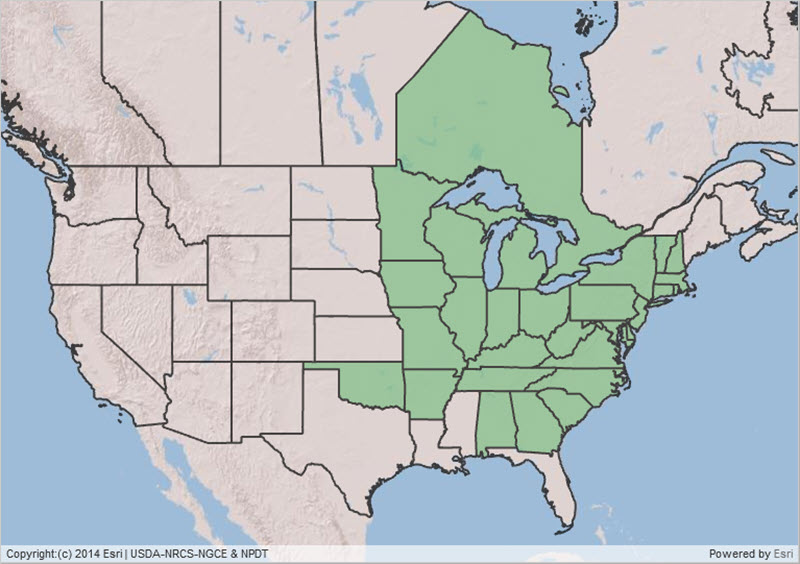Lily-leaved Twayblade (Liparis liliifolia)
By Chris Mattrick, White Mountain National Forest Botanist

Lily-leaved twayblade (Liparis liliifolia) is a North American endemic orchid occurring in 26 states and one Canadian province. Throughout its range it is relatively common, but in the northeast and particularly New England it is quite rare. Like many orchid species it has a specific fungal associate on which it relies for successful seed germination and seedling establishment. What is unique about the relationship between Liparis and its fungal associate is the lack of genetic variation within the fungus itself. It is virtually a clone throughout the entire twenty-six state and one province range of the species. It grows in a variety of habitat types including mesic to moist deciduous forests, pine forests and it is often found colonizing previously disturbed habitats during the early to mid stages of succession. In New England, the species is a bit more finicky. It is almost exclusively restricted to open, glade-like woodlands dominated by oak, ash, hickory, or cedar.

The scientific and common names of the species have seen their fair share of debate since the species was first described by Linnaeus in 1753. There has been a long a torrid debate over the correct spelling of the specific epiphet - liliifolia. In 1800 the species was transferred from its first genus Ophrys to Malaxis and the ‘i’ was doubled. The use of the double ‘i’ was the first spelling it type and ignited a debate that continued through 1967, when most modern taxonomists finally accepted the unusual spelling. This spelling controversy has also affected the species common name as well. The natural translation of liliifolia may seem to derive from Lilium (the genus of truly lilies), but in fact it is derived from an old-world group of plants: Lilia. Species in this group have one to a few basal leaves. So, the widely used common name, lily-leaved, may not be botanically correct. Perhaps one of the lesser used common names, of which there a several, would be more appropriate. My favorite is the mauve sleekwort! The generic name derives from the Greek term ‘liparos’ meaning fat or greasy in reference to the appearance of the leaves for most species in this genus.
Lily-leaved twayblade is typically 10-12 cm in height rising above two basal leaves that have a somewhat greasy and succulent appearance. The inflorescence is a loose raceme of 5 to 30 widely separated pale purple flowers. The flowering time varies from May in southern areas to July in the northern parts of its range. The lip of the flower is large in comparison to the rest of the plant and has a fine network of reddish/purple veins. This species belongs to a group of orchids that are pollinated by flies, specifically a group known as flesh flies. Flies in general are poor pollinator’s often visiting but rare affecting pollination. These flies may be attracted to the color of the flowers (resembling carrion), or an odor emitted by the flowers, although they are reported to have no perceptible odor to humans. It is postulated that in areas where Liparis is in decline that pollinator limitations may be significant cause of that decline or rarity.
Lily-leaved twayblade is ranges from Vermont and Massachusetts west to Ontario, Iowa, and Oklahoma and south to Georgia. It is relatively common throughout much of its range but is considered rare in AL, CT, DE, MA, NY, OK, ON, RI, and VT. Due to it elusive nature and lack of a showy display it is likely that more occurrences exist in states where the species is considered uncommon. Lilly-leaved twayblade occurs on the Midewin, Mark Twain, Shawnee, Hoosier, Monongahela, Allegheny, Wayne, and Huron Manistee National Forests in Region 9. It is considered a Sensitive Species on the Huron Manistee.
References
NatureServe. 2009. NatureServe Explorer: An online encyclopedia of life [web application]. Version 6.1. NatureServe, Arlington, Virginia. Available https://explorer.natureserve.org/. (Accessed: December 16, 2011).
Ramstetter, J. M. 2001. Triphora trianthpphpra (Swartz) Rydb. (Three-birds Orchid) Conservation and Research Plan. New England Wild Flower Society, Framingham. Massachusetts.
Mattrick, Christopher. 2004. Liparis liliifolia (L.) L.C. Rich. ex Lindley (Lily-leaved twayblade) Conservation and Research Plan for New England. New England Wild Flower Society, Framingham, Massachusetts, USA.
